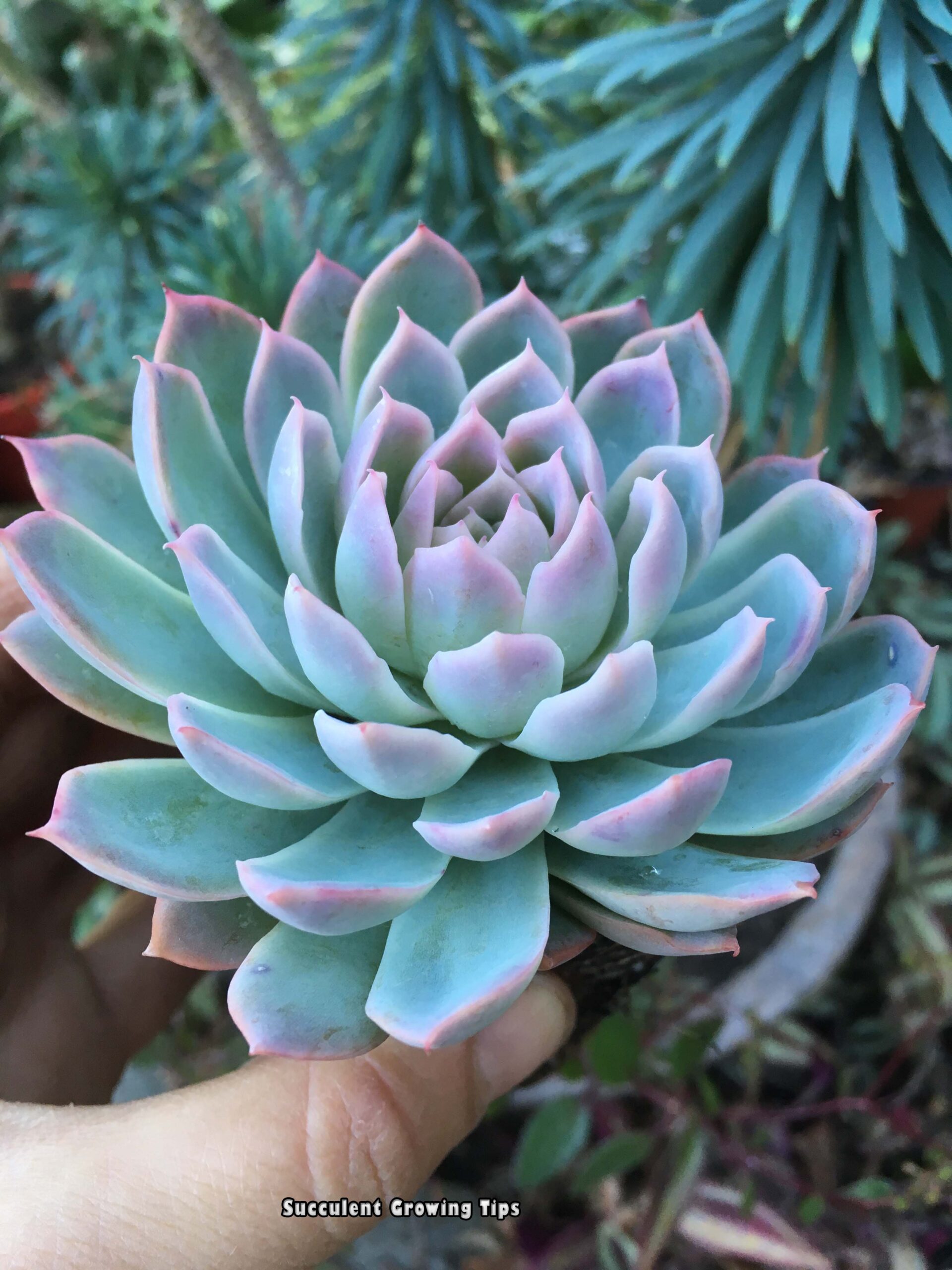Your cart is currently empty!

Echeveria Violet Queen Care & Propagation
Echeveria Violet Queen is a favourite among succulent growers because of its gorgeous rosette that looks like a lotus flower. It is also a fantastic hybrid as it is very hardy and perfect for the succulent newbies.
Description
Echeveria Violet Queen is an evergreen perennial succulent forming clumps of rosette shaped heads. The mother plant will grow pups in winter/ spring (depending on where in the world you are) and these pups will grow offsets of their own.
Violet Queen is prized for its pretty colours in the cooler months or, when the plant is stressed. The rosette colour is blueish-grey with a pinky hue, covered in a dusty coating called the farina. The farina protects plants from the elements and harsh sun. The leaves are long and pointy.
Echeveria Violet Queen can grow to approximately 15cm in diameter and 10cm in height in good conditions. If the plant is left to produce clumps, these can measure larger.
Flowers appear every spring and grow out of the rosette on a tall stalk. The stalk is pink and has multiple flowers arching over the rosette. The blooms themselves are pink and yellow.
Position & Care
To get the best colours and a compact shape Echeveria Violet Queen will need to live in a sunny spot outdoors. The only exception for it not to be out is during winter when temperatures are below the freezing point as the Violet Queen is not frost tolerant. It will, however, deal with temperatures as low as 0.5C (33F).
This plant is not suitable to be grown indoors unless it’s in a sunroom or on a windowsill getting over 5 hours of sun (it would have to be a seriously long and large window). If kept indoors for too long, Echeveria Violet Queen is likely to stretch towards the brightest light, grow green, leggy and eventually die.
In a climate where temperatures often go north of 37C (98.6F) Echeveria Violet Queen may need to be protected from harsh afternoon sun during heatwaves as the foliage can burn. This can be done by either moving plants to a spot where they will be in shade in the afternoon or by placing them under a 30% shade-cloth.
Echeveria Violet Queen can be grown in both pots and garden. It tends to grow better in the ground, though, if you live in a cold climate we wouldn’t recommend growing this plant in the ground as the winter frost and snow will kill it. In pots it is best to upgrade the pot yearly so the plant can multiply and grow bigger.
Echeveria Violet Queen is not particularly fussed about rain and too much water and is unlikely to suffer rot, warts or other water issues caused by too much water. It is a good idea to plant the Violet Queen in a good quality, well-draining potting mix if grown in pots. In the garden always plant in a part of the garden that does not get waterlogged.
If grown under cover or in a greenhouse, water when the potting mix has dried out from the last watering. The Violet Queen is drought hardy and will live for extended periods without any water whatsoever (1 month +). How long will depend on the climate, time of the year and age of the plant.
Propagation
Echeveria Violet Queen is best propagated by cuttings. A mature plant has the ability to grow more than 5 pups every year. The pups will need to be left to grow on the mother plant until there is a long enough stalk so they can be cut. If the stalk has not developed enough, there is a risk the whole pup will just fall apart.
The best time to cut pups off, if they are big enough, is in mid-late spring, after the danger of frost has passed. They will then need to be left to dry for a day. When the wound is dry, the pups can planted in a pot with succulent potting mix and placed in a bright spot with morning sun.
Echeveria Violet Queen will also grow from seed, though this method can be unreliable and extremely slow.
Leaf propagation is also a bit of a hit and miss. To start with it is very hard to take leaves off the plant without breaking them. The leaves also tend to die before producing any new growth/ only roots without plant will grow out of the leaf.
Pests
Although the usual suspects can attack Echeveria Violet Queen it is not one of their favourites. We have found mealybugs and Aphids on our plants many a time, but infestations are rare. If there are other, tastier plants present, these pests will leave Violet Queens alone.
Aphids mostly attack the flowers and so sometimes the whole flower spikes will need to be destroyed to keep Aphids in check.
Slugs, snails, grasshoppers and caterpillars are also potential predators, but again, they are not strongly attracted to Violet Queens if tastier plants are about.
Bigger animals like deer, birds or possums are also known to eat this plant.
Toxicity
Echeveria Violet Queen is listed as non toxic to humans, dogs, cats or other pets. It is, however, not recommended to eat these plants.
Where Can I Get Them
Violet Queen is quite a common succulent and can be found in garden centres, nurseries and online.